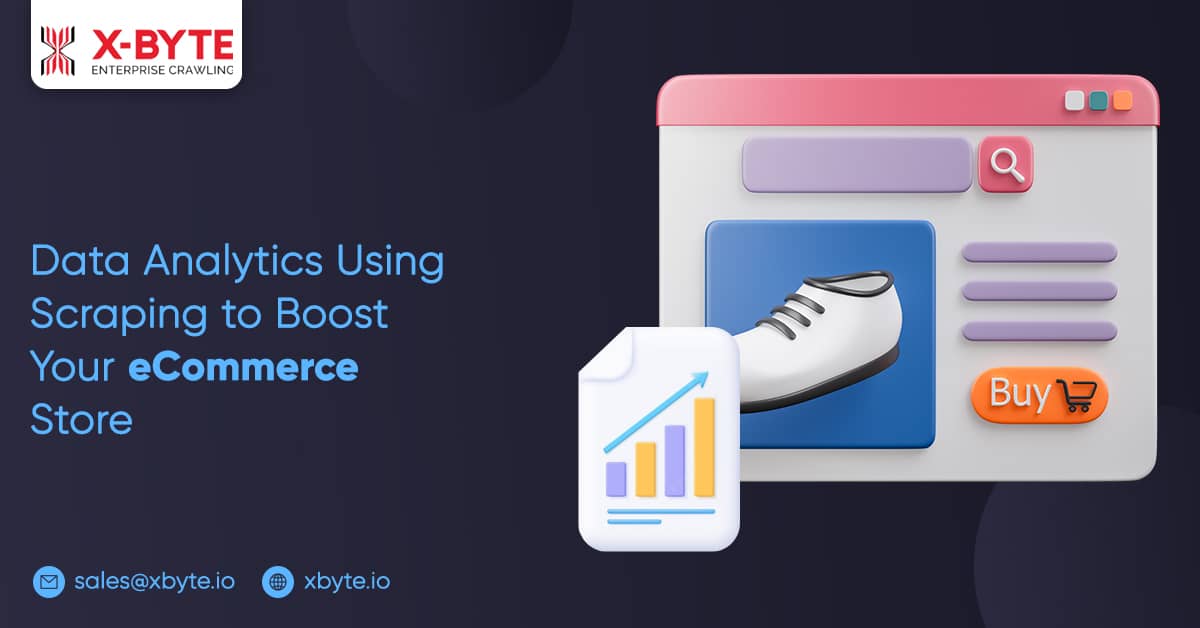
Are you one of the many eCommerce stores struggling to compete with Amazon? Whether you’re just starting or have been in the game for a while, if it’s time to find a way to get an edge on your competition and boost your sales, then Data Analytics is something that you should start considering now.
Our post will walk you through how to use scraping techniques to help grow your online store
1. What is eCommerce Data Scraping?

eCommerce data scraping refers to using software to browse different websites and gather the desired data. The scraped information can be saved in a spreadsheet or presentation for later use. Your eCommerce store can benefit from information scraped about product lists, pricing, availability, and many other components.
The ability to scrape any web content is becoming increasingly popular as it can provide you with valuable information that you may not have been able to obtain otherwise.
2. Practices of Web Scraping to Use in E-Commerce

You can use several practices to help you analyze the eCommerce data and make it work for your store.
You can have an automated web scraper hooked to your CMS system. This process is fast and efficient. There are also more manual approaches to scraping, for example, using a desktop application where you manually tab through the various pages of the website, pick out the relevant information and drag this information into an Excel spreadsheet. Another good practice is using Google Chrome or any developer tool to view the source code. You can do this by clicking on View Source on any page and copying any text of interest into a text editor such as Notepad++ or Visual Studio Code Editor. Web scraping covers seven leading practices:
-
- price-monitoring
- product optimization
- excellent customer analysis
- better advertising
- lead acquisition
- monitoring of competitive organizations
- online reputation
These practices can help you determine how to use your website to improve the user experience and boost your store’s conversion rates.
3. Strategies for ECommerce Scraping

There are several strategies for scraping eCommerce, each with advantages and disadvantages. The critical question is whether you can scrap without problems or suffer from unexpected errors. Here we will explain which techniques apply to which eCommerce stores and how to implement them.
We will start with a general-purpose web scraping technique that works for eCommerce store owners with existing online stores that aren’t selling anything new at the time of the scrape.
3.1. Competitor Price Monitoring:
The first strategy is to use web scraping to monitor your competitors’ prices. If your company has a competitor selling similar products, you can use the data extracted from the competitor’s website to make price adjustments in your eCommerce store. If the price changes in the competitors’ stores over time are significant, you can update your store for a small fee and get sales revenue.
3.2. Product Optimization
The following strategy involves using web scraping to figure out what products are popular and which are not selling so well so that you can change the product prices accordingly. This strategy helps scrape new products or used items without moving any goods, thus saving on costs and getting more revenue.
3.3. Increase Visibility Through SEO Analysis:
These days, many eCommerce stores use SEO-oriented websites to boost the visibility of their products. If running a store that depends on Google’s search engine listings, you can use tools such as Screaming Frog to analyze your site’s content and check for broken links. It can help you discover obsolete links and work on them before things get out of control for your website or Google search engines.
3.4. Monitor Product Performance:
Another strategy is to use web scraping to monitor product performance. For example, by using keywords in your product title, you can use SPARQL (Simple Protocol for Arranging RDF Resources) queries to get information about the products and their prices. You can also use this strategy to analyze your sales, not just your competitors’ sales.
3.5. Competitor Monitoring:
Another web scraping technique useful for eCommerce stores is to track your competitors using hub pages which will show the prominently displayed links from other sites, Google searches, and social media pages. Search engines and social media websites like LinkedIn, Twitter, and others use hub pages.
3.6 Ability to Generate Sales Leads:
Most eCommerce stores generate sales leads for other products that may be useful for the customers visiting their store. Suppose you’re using web scraping to acquire new customers. In that case, you can use information from your competitors’ websites and create a mailing list to advertise your products through email or social media messaging.
3.7. Efficient Product Launch & Optimization:
One of the most commonly used strategies is web scraping to launch a new product and test the market reaction. If you can see what other products are popular or what others think about your new product, then you can apply this feedback to determine whether your product will sell well and increase sales later.
How Can Your Business Leverage E-Commerce Web Scraping?

Your business can leverage e-commerce web scraping in several ways to achieve your goals. However, you must carefully consider the types of scraped data, the sources, and the costs. By using web scraping, your business can improve its ability to market to customers and learn more about what those customers want.
Conclusion
The purpose of eCommerce Web Scraping is not to steal data but to store it. You should not use scraped data for illegal purposes and should use it ethically. As the owner of your website, you need to ensure that the web scraping code does not necessarily ‘touch’ every page but only accesses the pages where you are legally allowed to do so. If a user is logged in, then you need to have full consent from that user before accessing the personal information stored by the website.
Scraping can help your eCommerce store generate more revenue and decrease costs to keep your store open. Using web scraping techniques, you can collect data on new products, monitor competitors, check site performance metrics, and generate leads for sales. You also can use web scraping to look at your competitors’ pricing on eCommerce websites that offer competitive prices for similar products. If your competitor’s prices are always lower than yours, you can leverage web scraping to give yourself a competitive edge.
The bottom line is that no matter how small or large your eCommerce store is, you should consider using web scraping techniques to boost its performance and make it more efficient. Many online stores use web scraping strategies to maintain sales or increase revenue.
